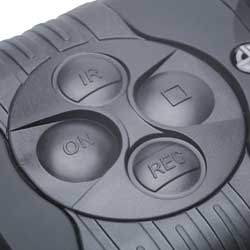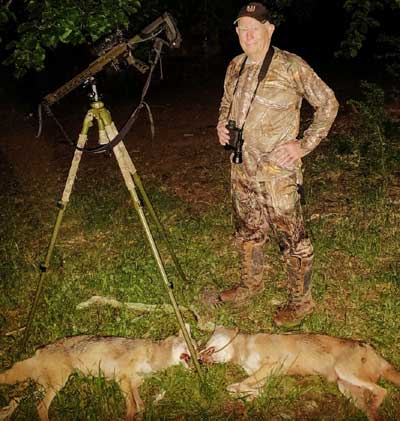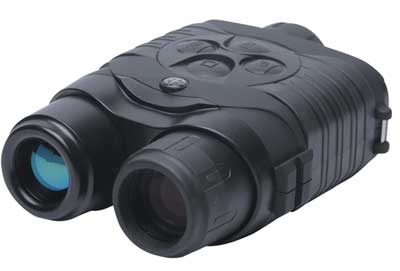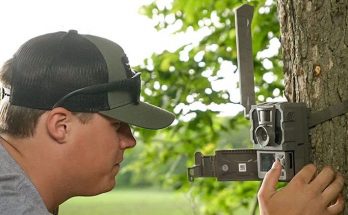The SightMark Signal 320RT Night Vision Monocular offers the hunter an affordable night vision scanner for a reasonable price. The Signal uses a 640×480 CMOS sensor, 640×480 LCD display and built-in 850nm LED IR illuminator provide very good night time performance. The digital night vision monocular features built-in video recording with sound and connects to smart phones via the Stream Vision app, allowing users to remote view/control the Signal and stream videos directly to YouTube with 8 Gb of internal memory.
The Signal N320RT is able to double magnification from 4.5 to 9 power with digital zoom with press of button. Other useful features include bright light exposure resistance technology, front focus objective lens, an attached Weaver rail for additional accessories and an intuitive easy-to-use interface. The Signal N320RT 4.5×30 includes a carrying case, user manual, USB cable, neck strap and lens cloth.
After doing a few hunts at night for coyotes and hogs using lights, I liked it so much I wanted to upgrade to a night vision device before jumping into the thermal scanners and scopes. I went to the guys I trust at Outdoor Legacy for their advice. Jason Robertson and Joel Miller (HansETX) are the best people I know when you want information about night vision and thermal scopes . After seeing one of their Youtube videos about night vision scanners, I ordered a Sightmark Signal 320RT from Outdoor Legacy. The plan is to use this scanner in conjunction with the new Wraith Digital Night Vision Scope, available soon.
Signal 320RT Night Vision Monocular Test
My initial use of the Signal 320 proved to be good but challenging. The Signal 320RT is a digital night vision monocular designed for scanning and and it works very well in open areas like hay fields or other open country. In heavy wooded areas, I got a lot of bright reflection from the close trees that hampered me from seeing deep into the woods. This was my first outing, so there may be settings available I was not aware of for wooded areas.
My first night out was on an almost moonless night. Scanning across a hayfield I immediately picked up a couple of rabbits about 125 yards out, not only bright shinning eyes, but full body images. It is sort of like watching black and white television as you scan except for the red eyes.
The second outing was on a night with full moon and I could see over 400 yards and details of cattle, tractors, hay bales and landscape. Scanning from high elevations is a plus because it reduces the reflection from high grass or bushes. Later I was able to see a coyote streaking across the field with no problem but forgot to hit the record button.

The Signal 320 is controlled using four buttons on top of the unit. These buttons are used to turn the unit off and on, record, adjust the IR brightness and magnification from 4.5 or 9X. Combinations of buttons or holding down buttons momentarily let you access the menus.
The unit also has ocular and objective lense adjustments for focusing. Focusing is not as easy as binoculars because you are actually looking at a digital image of the area, not simply looking through glass lenses.
The Signal 320 works very well on moonless nights, but the more moon light the better. You can stretch the range even more by attaching an external IR illuminator to the weaver rail on the side of the Signal. The IR illuminator looks like a small flashlight and works the same way to help you see more at night.
Here is one of the first videos made with my Sightmark Signal 320 RT. Several deer playing around in a field. The distance to the deer range from 50-150 yards.
I am still in the early stages of use, but I can tell you that I really like it so far. As I get into more use and produce some videos, I will keep you up to dated.
Sightmark Signal 320RT UPDATE

I have had a couple of more opportunities to put the Sightmark Signal 320RT to work, and the more I use it, the more I like it. With a little moon light for help, I was able to spot and identify the first coyote during last night’s hunt at about 200 yards. If only my shooting was as good as the Sightmark Signal 320RT :(! Scanning the treeline across an open flat hay field, I was able to quickly see the eyes of Mr. Yote and then the clear outline of his head and body as he came into the field to make a quick ID and a bad shot.
Lucky for me that later that night I was able to connect on a double. Called three into range and got two. That is a good hunt.
The first job of a scanner is detection and the second is ID. For hunters upgrading from lights to a Digital Night Vision Scanner, you will definitely improve your odds in the field. I have an external IR illuminator for the Signal, but I seldom use it unless I am viewing from a hilltop. I think Sightmark hit the balance with the Signal, providing sufficient internal IR for the clarity of the monocular. If you are a hunter that hunts vast open fields, you may need to go to a thermal scanner, like a Pulsar Axion, but for hunters where your viewing will be 250 yards and under, the Signal 320RT may be just what you need.
Another concern hunters have about Night Vision Optics is the battery life. I ran the Signal from 9-12:30 PM last night on a set of rechargeable RayHom AA batteries . At the end of the hunt, the battery indicator showed a little less than half a charge remaining. I pretty much ran the display on the entire time of the hunt with only a few minutes with the display off. I think the battery life will meet the advertised time of 5 hours on quality batteries.
There are a few cons to any digital night vision scanner. Dust, fog, smoke and tall vegetation reflect the light. Viewing from elevated areas works best where you have vegetation like tall grass in front of you so you get less reflection. If the fog rolls in , you see the fog. Gun smoke sometimes blocks your view temporarily at times. Of course, fog or smoke blocks your view anyway, so a light gathering monocular is sort of like driving with high beams in the fog. You learn to live with it and adjust quickly.
The other drawback is excitement. I get caught up in the moment of seeing the coyote working and forget to hit the record button to get a short clip of my hunt to share. After hunting for over 50 years, I still feel the adrenaline rush, and the Signal 320RT is just adding fuel to the fire.
Sightmark Signal 320 Specs
| Display type | LCD |
| Display Resolution, pix. | 640×480 pix |
| Built-in Video Recorder Availability | Yes |
| Built-In Memory, Gb | 8 Gb |
| Video Clip, Format | *.avi |
| Video Clip, Resolution | 320×240 or 640×480 |
| Format of photo files | *JPG |
| Resolution of photo files | 320×240, 640×480, 1280×960 |
| Built-In Memory, Gb | 8 Gb |
| Built-in Video Recorder Availability | Yes |
| WiFi frequency | 2.4GHz |
| WiFi reception range ft/m | 50 / 15 ft/m |
| Magnification | 4.5/9 |
| Reticle, Type | 30 |
| Lens Focus | 30 |
| Relative Aperture | 1:1.05 |
| Reticle, Type | 7.7 |
| Field of view, m@100m | 13.4 |
| Field of view, ft@100yd | 40.2 |
| Reticle, Type | 16.4/5 |
| Eye relief (in/mm) | .5/14 in / mm |
| Diameter, Exit Pupil | 3.5 mm |
| Diopter Adjustment | +5 to -5 |
| IR Emitter | LED |
| IR Wavelength | 850 nm |
| Range of Detection, m (Object 1,7m High, Illuminatuin Level 0,05 lux(“1/4 moon”) | 380/350 yd/m |
| Power Supply | 4-6.5 V |
| Battery Type | 4xAA |
| Battery Life, (w/out IR), hour | 5 |
| Reticle, Type | 3 |
| External Power Supply | 5V – Micro USB |
| Body Material | ABS Plastic |
| Tripod Mount | 1/4 |
| Nitrogen Purged | No |
| Fog Proof | No |
| Shockproof | No |
| Waterproof Rating | IP55 – water resistant |
| Operating temperature, F/C | -5 to 122 / -15 to 50 F/C |
| Length (in/mm) | 6.61/168 in / mm |
| Width (in/mm) | 4.37/111 in / mm |
| Height (in/mm) | 2.2/56 in / mm |
| Weight, oz | 12.3 oz |
Related Posts Thermal Hunting Video



